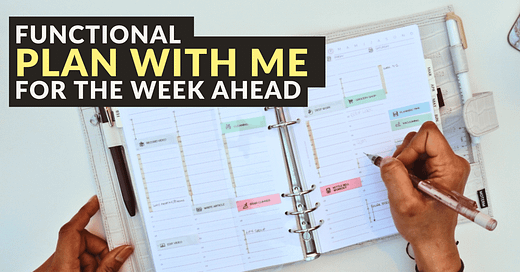How I Actually Plan My Week (Not Just a Pretty Planner!)
A simple, flexible system for balancing work, life, and side projects.
Planner overwhelm is real. If you’ve ever felt like your planner looks great but doesn’t actually help you get things done, you’re not alone.
I’ve tested multiple setups, and after juggling a part-time job, content creation, and family life, I’ve found that simplicity is key. Here’s exactly how I plan my week to stay on top of everything—without overcomplicating my system.
The Tools I Use to Plan My Week
I keep my system simple and functional, using just two planners:
Work Planner – Manages my job-related tasks, client projects, and appointments.
Life & Side Hustle Planner – Captures everything else, from content planning to home life.
Key Insight: I don’t overload my planner with trackers, sections, and layouts I won’t use. I stick to the essentials that actually help me stay on track.
My Weekly Planning Process
Step 1: Review My Monthly Plan
I start by checking my Month on One Page Insert, which includes:
Calendar Grid: Key dates, appointments, school holidays.
List View: An index of important events, commitments, and deadlines.
This gives me a big-picture view of what’s coming up.
Step 2: Blocking Out Non-Negotiable Commitments
Before filling in my Weekly on Two Pages Inserts with the things I need to get done, I highlight:
Work hours (since I can’t schedule anything personal during this time).
School runs and family commitments (so I know when I’m unavailable).
Other time-sensitive obligations (meetings, events, etc.).
Why? This shows me where my free space is, so I don’t overbook myself.
Step 3: Using Page Flags for Flexible Task Management
Rather than rigidly scheduling everything, I use task tabs (page flags) to:
List tasks I need to complete this week.
Move them around based on energy levels and availability.
For example, if I don’t feel like working out on Monday, I just move the workout tab to another day—no guilt.
Why I Keep It Simple (And You Should Too!)
In the past, I tried to over-optimize my planner—adding habit trackers, daily reflections, and sections for everything. But I realized that:
The more complex my planner, the less I actually used it.
Flexibility is key—life changes, and my planner should adapt.
White space is necessary—I leave room for spontaneity and downtime.
Takeaway: You don’t need an elaborate planner to stay organized. Focus on what actually helps you move forward, not what looks impressive.
Final Thoughts: Planning in a Way That Works for You
The way I plan my week might not work for you exactly, but the key takeaway is:
Make your planner work for your life, not the other way around.
Keep it simple and flexible—life isn’t rigid, so your planner shouldn’t be either.
Experiment and adjust—don’t be afraid to change things up.
How do you plan your week? Do you prefer a structured system or a more flexible approach? Let me know in the comments.








